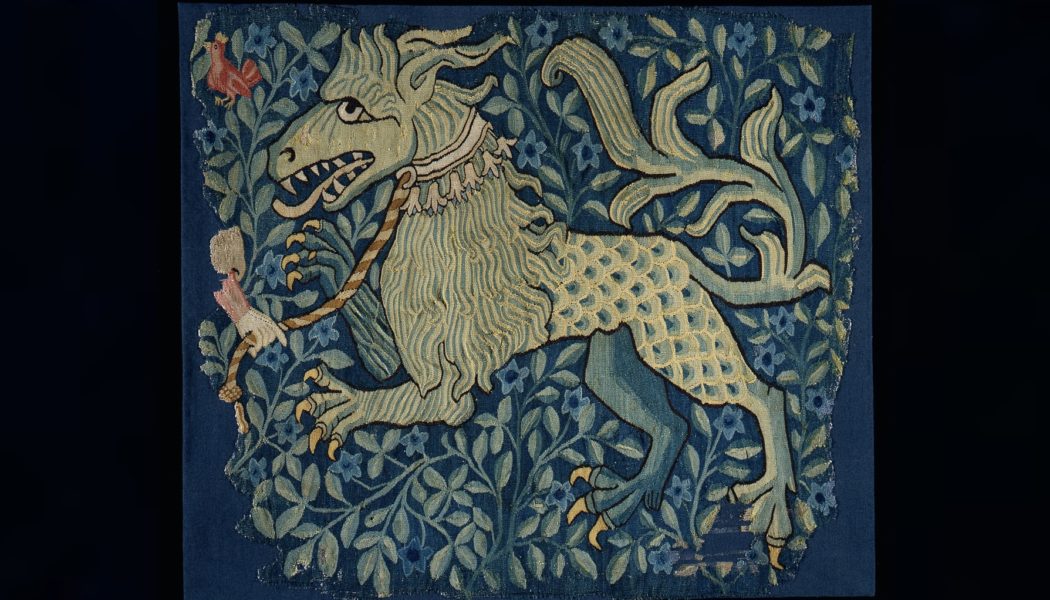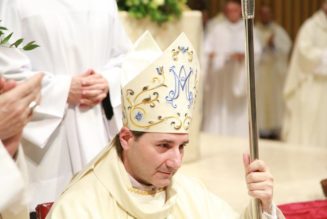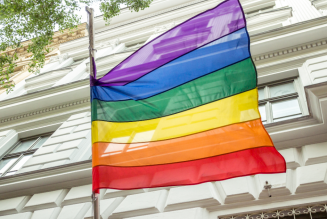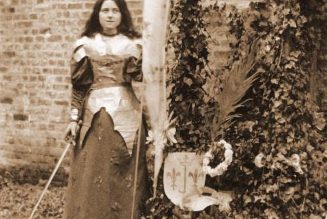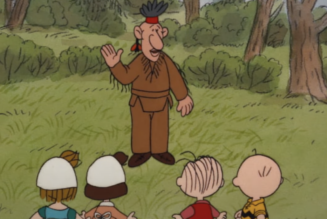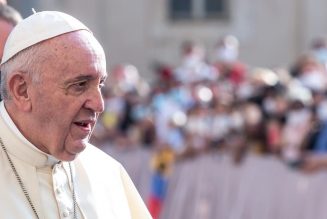
All sorts of strange animals bounded through medieval minds.
There were the blemmyes, beings who wore their faces on the front of their torsos, and the bonnacons, bullish beasts that fought their foes with fireballs of dung. There were sea monks and mermaids and mermen, not to mention the many species of sea serpents. And while barnacle birds fell from trees as if they were fruit, some mythical sheep were thought to be suspiciously strong thanks to the wriggling worms that sat inside their brains.
Of course, certain creatures appeared in the stories and artworks of the Middle Ages and Renaissance much more than others. In many ways, the dragon, the griffin, and the unicorn were the three mythical darlings of medieval Europe. They appeared again and again, in written words and in illustrations, but what did their appearances actually mean?
Taken one at a time, these three mythical creatures alluded to a wealth of abstract ideas, from sin to strength to shimmering purity. Their stories speak of triumph and tragedy, of virtue and vice — all the things that captivated medieval minds, and that continue to captivate modern minds today.
Read More: Are Dragons Real? The Unique History and Origins of Mythical Dragons
1. Dragons: Sinful and Scaly
(Credit: The Metropolitan Museum of Art’s Open Access Collection).
An unnamed artist active in Italy painted this painting, titled “Saint Michael and the Dragon,” around 1405. The stories of Saint Michael and Saint George were well known in the Middle Ages and Renaissance for featuring dragons, though there were many other saints who were also depicted battling the beasts.
The dragons of the Middle Ages and Renaissance were always fierce, and almost always fiery. Torching their foes with their toxic, burning breath, these serpentine beasts inhabited dark and dense habitats, hoarded treasure, and had a terrible habit of harassing humans.
The Origins of Dragon Mythology
Some scholars have suggested that humans inherited an instinctive fear of snakes from our ancient ancestors, fueling the idea of the dragon. Others have said that the invention of the dragon flowed from discoveries of dinosaur fossils. Either way, dragons were well established in European minds already in antiquity, with the word drákōn appearing in ancient Greek texts around 800 to 700 B.C.
What Did Dragons Look Like?
At the time, dragons were thought to look like large, snake-like beasts. Some had four legs, some had two legs, and some had no legs, and if they had wings, they were thick and leathery.
Resembling snakes and and residing underground or in the undergrowth, these dragons reflected the real threats that lurked in the ancient wilderness. And this association with snakes survived well into the Middle Ages, with medieval authors and artists stressing the animal’s serpentine attributes.
Mythical Dragons in Literature
“The dragon began to belch out flames and burn bright homesteads,” tells the Anglo-Saxon poem Beowulf, which was made into a manuscript around A.D. 1000 and stresses the venomous bite and breath of a beast that left “nothing alive in his wake.” Throughout the text, the dragon’s movements are described by the Anglo-Saxon word bugan, “to bend,” which signifies its snaky similarities.
Telling the tale of a brave warrior who defeats a dragon, Beowulf included and actually invented many of the tropes that defined the dragons and dragon tales of the Middle Ages and Renaissance. The beast in Beowulf flew, flung fire, and hoarded treasure. It terrorized townspeople. And inspiring the tales that followed the Beowulf text, the warrior who faced the dragon was fated for tragedy, slaying the beast but being mortally injured in the battle.
What Did Dragons Symbolize?
In the majority of medieval and Renaissance-age stories, dragon-slayers dueled dragons to take their treasure or to free the feeble from their terrible wrath. And whether the dragon-slayers succeeded in their task, their battles took on a thoroughly religious tinge. To the Christian audiences at the time, dragons were bearers of death and destruction — symbols of sin and the various vices combatted by Christians and their collective Christian Church.
Read More: The Mystery of Extraordinarily Accurate Medieval Maps
2. Griffins: Ferocity in Fur and Feathers
(Credit: The Metropolitan Museum of Art’s Open Access Collection).
The artist Wenceslaus Hollar produced this print, titled “A Griffin,” in the 1660s. The Bohemian image appeared in the artist’s “Animalium, Ferarum, & Bestiarum” series and combined the fiercest features of both beasts and birds.
A majestic squawk — or maybe a magnificent roar — announced this creature to its ancient and medieval imaginers.
What Are Griffins?
Capable of soaring through the air and tearing through the terrain on four feathered paws, the griffin was one of many mythical mishmashes that populated stories and art from centuries ago. Alongside its feline screech and its avian snarl, the griffin resonated in ancient and medieval minds as a symbol of strength.
The Origins of Griffin Mythology
Griffins appeared in antiquity with the heads, torsos, talons, and wings of eagles and the legs and tails of lions. According to the Romans, these mythical mash-ups prowled the plains of Asia, where the world’s most daring miners traveled to discover gold. “The place where the griffins live and the gold is found is a grim and terrible desert,” Aelian, a Roman author and rhetorician reported in A.D. 200 in a famous account of the foreign animals.
According to Aelian, the miners who managed to avoid griffins reaped a “double reward” and a “rich profit” in return for the risks that they faced. Tenaciously guarding the area’s gold, griffins were so strong that they were almost impossible to fend off. This idea of the griffin as a fearsome force, guarding gold and other valuables in foreign lands, survived through antiquity and into the Middle Ages and Renaissance.
What Were Griffins Like?
Around A.D. 600, Isidore, a Spanish academic and archbishop of Seville, reiterated the ancient concept of the griffin as part eagle and part lion. “They tear men to pieces,” the archbishop added, cementing another aspect of their mythology. Centuries later, accounts of Central Asia claimed “the griffin has a body that is larger than eight lions and larger and stronger than a hundred eagles,” allowing them to capture knights and carry them around.
Mythical Griffins in Literature
Throughout the Middle Ages and Renaissance, and particularly throughout the time of the Crusades, griffins appeared in nearly constant combat with medieval knights in writings and illustrations. Between the A.D. 11th and 13th centuries, battles between knights and griffins became symbols of military strength and faraway military missions.
What Did Griffins Symbolize?
Griffins were also a sign of authority closer to home. Combining the attributes of the “king of beasts” and the “king of birds,” the griffin conveyed courage, control, and authority when they appeared in the crests and the coats of arms of various medieval monarchs. And like most mythical creatures, the griffin also took on an association with Christianity, since the creature was both beast and bird, like Christ, who was both mortal and divine.
Read More: Just How Dark Were the Dark Ages?
3. Unicorns: Symbols of Peace and Purity
(Credit: The Metropolitan Museum of Art’s Open Access Collection).
Weavers from the Netherlands wove this tapestry, titled “The Unicorn Defends Himself,” between around 1495 and 1505. The tapestry was part of a series of seven separate woven pieces, which told the story of a unicorn hunt. Here, the hunters prepare to pierce the unicorn with their spears.
In comparison to the vile, violent dragon and the ferocious griffin, unicorns were imagined as peaceful and pure. Famed for the single, spiral horn on the top of its head, the unicorn of the Middle Ages and the Renaissance was a beautiful white beast — a symbol of innocence, virtue, and virginity — with the body and hooves of a horse.
The Origins of Unicorn Mythology
Once again, the medieval interpretation of these benevolent beasts took its inspiration from antiquity. According to the ancient Greeks, unicorns were actual animals that wandered through the far-flung forests of Asia. And while Greek storytellers spoke of unicorns, Greek naturalists included unicorns in their accounts around 400 B.C.
Mythical Unicorns in Literature
By A.D. 550, the medieval tradition of the unicorn was already starting to take shape, with Alexandrian author Cosmas Indicopleustes writing that “it is impossible to take this ferocious beast alive” since “its strength lies in its horn.” If a unicorn “finds itself pursued and in danger of capture,” the author adds, “it throws itself from a precipice, and turns so aptly in falling that it receives all the shock upon the horn, and so escapes safe and sound.”
What Were Unicorns Like?
In time, most medieval interpretations imagined unicorns as timid animals, that wandered through the forests and were so free of sin they purified any poisoned waters that they found as they traveled. Though they were almost always weary of men, some stories suggested they befriended beautiful young maidens, though these friendships were typically to the detriment of the unicorns.
Unicorns in Medieval Art
In fact, many medieval stories and artworks tell the tale of a unicorn meeting a maiden in the middle of the forest. After tentatively approaching the maiden, the unicorn lays its head in the maiden’s lap and falls asleep. As the unicorn slumbers, the maiden starts to sob, and men descend on the sleeping beast, slaying and seizing its body. For the members of its medieval audience, the tragic story invoked the passion of Christ.
“The unicorn,” Leonardo da Vinci wrote alongside a pen-and-ink illustration of a unicorn in the midst of the Renaissance, “forgets its ferocity and wildness, and laying aside all fear, it will go up to a seated damsel and go to sleep in her lap, and thus the hunters take it.”
What Did Unicorns Symbolize?
Thanks to these stories, unicorn horns were thought to have magical and medicinal properties throughout the Middle Ages and Renaissance. The tusks of narwhals were advertised as high-valued horns, which were supposedly capable of counteracting poison, curing plague, and prolonging youth. Though not rooted in truth, the horns made the myth of the unicorn more real, maintaining ancient fiction in the realm of medieval fact.
Read More: Science Was Alive and Well in the Dark Ages
Services Marketplace – Listings, Bookings & Reviews
